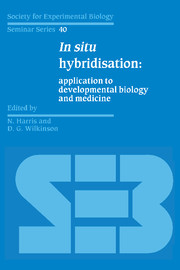Book contents
- Frontmatter
- Contents
- List of contributors
- Preface
- Non-radioisotopic labels for in situ hybridisation histochemistry: a histochemist's view.
- Use of haptenised nucleic acid probes in fluorescent in situ hybridisation
- The use of complementary RNA probes for the identification and localisation of peptide messenger RNA in the diffuse neuroendocrine system
- Contributions of the spatial analysis of gene expression to the study of sea urchin development
- Advantages and limitations of in situ hybridisation as exemplified by the molecular genetic analysis of Drosophila development
- The use of in situ hybridisation to study the localisation of maternal mRNAs during Xenopus oogenesis
- In situ hybridisation in the analysis of genes with potential roles in mouse embryogenesis
- Evolution of algal plastids from eukaryotic endosymbionts
- Localisation of expression of male flower-specific genes from maize by in situ hybridisation
- Tissue preparation techniques for in situ hybridisation studies of storage-protein gene expression during pea seed development
- Investigation of gene expression during plant gametogenesis by in situ hybridisation
- Sexing the human conceptus by in situ hybridisation
- Non-isotopic in situ hybridisation in human pathology
- The demonstration of viral DNA in human tissues by in situ DNA hybridisation
- Index
In situ hybridisation in the analysis of genes with potential roles in mouse embryogenesis
Published online by Cambridge University Press: 04 August 2010
- Frontmatter
- Contents
- List of contributors
- Preface
- Non-radioisotopic labels for in situ hybridisation histochemistry: a histochemist's view.
- Use of haptenised nucleic acid probes in fluorescent in situ hybridisation
- The use of complementary RNA probes for the identification and localisation of peptide messenger RNA in the diffuse neuroendocrine system
- Contributions of the spatial analysis of gene expression to the study of sea urchin development
- Advantages and limitations of in situ hybridisation as exemplified by the molecular genetic analysis of Drosophila development
- The use of in situ hybridisation to study the localisation of maternal mRNAs during Xenopus oogenesis
- In situ hybridisation in the analysis of genes with potential roles in mouse embryogenesis
- Evolution of algal plastids from eukaryotic endosymbionts
- Localisation of expression of male flower-specific genes from maize by in situ hybridisation
- Tissue preparation techniques for in situ hybridisation studies of storage-protein gene expression during pea seed development
- Investigation of gene expression during plant gametogenesis by in situ hybridisation
- Sexing the human conceptus by in situ hybridisation
- Non-isotopic in situ hybridisation in human pathology
- The demonstration of viral DNA in human tissues by in situ DNA hybridisation
- Index
Summary
Introduction
The mouse is widely used as a system for the study of mammalian development, and many studies have documented the morphological events that occur as tissues first form and become organised in the post-implantation embryo. However, very little is known of the molecular mechanisms that underlie these morphogenetic processes. In large part this ignorance is due to technical problems in studying embryos that are small, relatively inaccessible, and in which systematic genetics is difficult. One approach towards understanding development is to identify and analyse the function of genes that may have roles in the early events of the formation and spatial organisation of tissues. There are three phases to this type of approach; first, to select candidate genes suspected of having potential roles in development; second, to study their expression pattern in order to gain clues as to what process (or processes) they may be involved in; and third, to analyse their function by manipulative experiments guided by knowledge of their normal expression patterns. Below, we will discuss some of the ways that candidate developmental genes have been selected, and their expression patterns studied by in situ hybridisation.
Selection of candidate developmental genes
Genetics
The most direct way to identify genes with developmental roles is through the use of genetics, an approach that has been conspicuously successful for the analysis of Drosophila embryogenesis (Akam, 1987; Ingham, 1988). A large number of genetic loci have been identified that affect various aspects of development in mice. Many of these loci may encode products with rather widespread physiological roles that disrupt development in a pleitropic manner, but at least some may be directly involved in patterning tissues.
- Type
- Chapter
- Information
- In Situ HybridisationApplication to Developmental Biology and Medicine, pp. 131 - 142Publisher: Cambridge University PressPrint publication year: 1990
- 2
- Cited by



